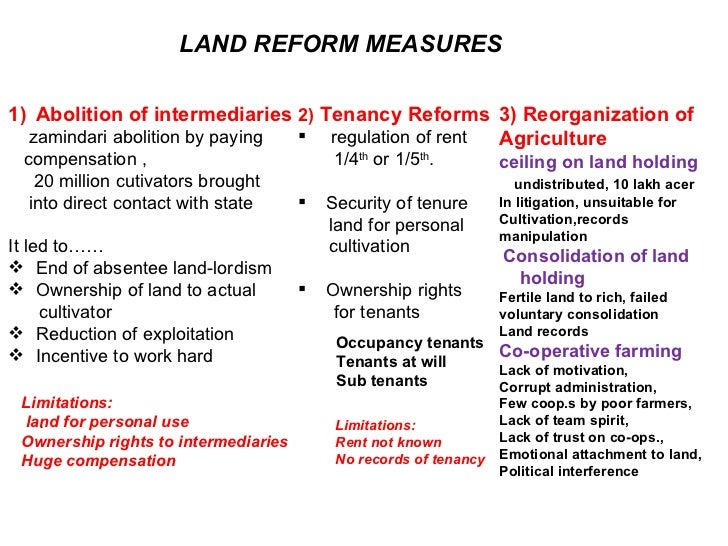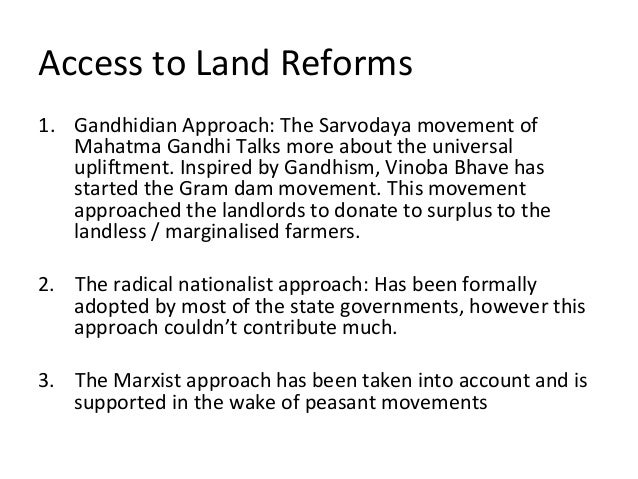Relevance: Sociology: Social Structure: Rural and Agrarian Social Structure: The idea of Indian village and village studies.
Agrarian social structure – evolution of land tenure system, land reforms

- However, progress in this respect has been poor. The Five Year Plan documents say that “in several States, information regarding tenants, sub-tenants and crop-sharers has not been obtained yet.” It has further been highlighted that large areas of the country still do not have up-to-date land records. The main reason behind this has been strong opposition of big landowners.
- Though the legislations were passed by all the states, only in some cases they produced desired effects. It has been argued that only in those parts of the country where peasants were politically mobilized that the land reforms could be effectively implemented. While the zamindari system was abolished in most parts, the ceiling legislations had very little effect.
- The process of agrarian reforms is inherently a political question. The choices made by the Indian state and the actual implementation of land reforms were determined by the politics of the new regime rather than by the theoretical superiority of a particular position. The Indian state chose to reorganize agrarian relations through redistribution of land but not in a comprehensive and radical manner. Joshi described it as sectorial or sectional reforms. The Government of India directed its states to abolish intermediary tenures, regulate rent and tenancy rights, confer ownership rights on tenants, impose ceilings on holdings, distribute the surplus land among the rural poor and facilitate consolidation of holdings. A large number of legislations were passed by the state government over a short period of time. However most of the legislations provided loopholes that allowed the dominant landowners to tamper with land records by redistributing land among relatives, evicting their tenants and using other means to escape the legislations. In the absence of concerted political will land reforms could succeed only in regions where the peasantry was politically mobilized and could exert pressure from below.

- Despite overall failure, land reforms succeeded in weakening the hold of absentee landlords over rural society and assisted in the emergence of a class of substantial peasants and petty landlords as the dominant political and economic group. For example in Rajasthan though the abolition of Jagirs was far from satisfactory it made considerable difference to the overall land ownership patterns and to the local and regional power structures. The Rajputs possessed much less land after the land reforms than they did before, Most of the village land had moved into the hands of those who could be called small and medium landowners.
- In qualitative terms most of the land begins to be self-cultivated and the incidence of tenancy declined considerably. The fear of losing land induced many potential losers to sell or rearrange their lands in a manner that escaped legislations.
- However in few cases the landless laborers living in the countryside most of whom belonged to the ex-touchable castes received land. The beneficiaries by and large belonged to middle level caste groups who traditionally cultivated land as a part of the calling of their castes.
- While land reforms were supposed to deal with the problem of landlordism, the hold of moneylenders over the peasantry was to be weakened by providing credit through institutional sources initially by credit societies and later by the nationalized commercial banks. According to the findings of an official survey carried out immediately after Independence from colonial rule up to approximately 91% of the credit needs of cultivators were being met by informal sources of credit. Much of this came from moneylenders. Indian state planned to expand the network of cooperative credit societies. With the imposition of social control and later their nationalization, commercial banks were also asked to lend to the agricultural sector on priority basis. Over the years the dependence of rural households on informal sources has come down significantly.
- The assessment studies on the cooperative credit societies showed that much of their credit went to the relatively better of sections of rural society and the poor continued to depend on the more expensive informal sources. This was explained as a consequence of the prevailing structure of land tenures. The state response was to bureaucratize the cooperative societies. Though in some regions this helped in releasing credit societies from the hold of big landowners, bureaucratization also led to rampant corruption and increasing apathy among those whom they were supposed to serve.
- Yet despite inherent bias of institutional credit against the rural poor, its availability played an important role in making the Green Revolution a success and definitely helped to marginalize the professional moneylender in the rural power structure. Despite many loopholes, apart from increasing productivity of land, these changes have transformed the social framework of the Indian agriculture. Agriculture in most parts of India is now carried out on commercial lines. The old structure of Jajmani relations has more or less completely disintegrated, giving way to more formalized arrangements among the cultivators and those who work for them. Some scholars have these changes indicate that capitalist form of production is developing in agriculture and a new class structure is emerging in the Indian countryside.


One comment